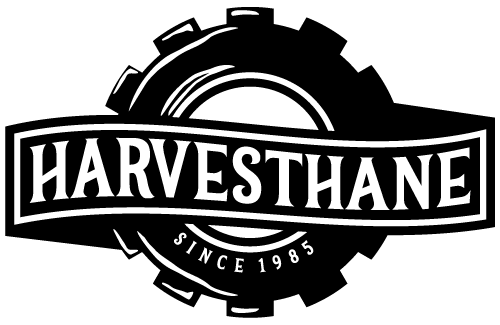URETHANE (AU, EU) Polyurethane diisocyanate
Advantages: Outstanding resistance to abrasion and tear; very high tensile strength with good elongation; excellent resistance to weather ozone, and sunlight; good resistance to oil and gasoline; excellent adhesion to fabrics and metals.
Limitations: Poor resistance to alkalis, acids, and oxygenated solvents; inferior resistance to hot water.
Comment: Urethane is notable for its combination of hardness with elasticity, and outstanding abrasion resistance and tear strength. It may be either ether or ester based. The ester based polymer is superior in resistance to abrasion and heat and the ether based polymer has better flexibility at low temperatures. Urethanes are sold in liquid or dry form and a casting process is usually used for viscous liquid form. Conventional rubber equipment is used for processing urethane in millable gum form. The dry type has physical properties slightly inferior to those of the liquid type. Urethane is a relatively expensive elastomer whose use is usually limited to applications that require a combination of its outstanding properties, such as toughness, tear strength, and abrasion resistance.
SILICONE (SI) Polysiloxane
Advantages: Outstanding resistance to high heat; excellent flexibility at low temperatures; low compression set; very good electrical insulation; excellent resistance to weather, ozone, sunlight and oxidation; superior color stability.
Limitations: Poor resistance to abrasion, tear, and cut growth; low tensile strength; inferior resistance to oil, gasoline, and solvents; poor resistance to alkalis and acids.
Comment: The most outstanding feature of silicone is its ability to retain rubbery properties through extremes in temperature. It is the most heat resisting elastomer in the market today and the most flexible at low temperatures. Service temperatures range from -150 to 500F. Silicone generally does not have high tensile strength, but much of the strength it does have can be retained at very high temperatures. Because silicone is relatively expensive, it is not normally used unless extreme temperature resistance is essential.
HYPALON (CSM) Chlorosulfonated polyethylene
Advantages: Good flame retardance; good abrasion resistance; superior resistance to weather, ozone, sunlight, and oxidation; excellent resistance to alkalis and acids; very good color stability; moderate resistance to oil and gasoline.
Limitations: Poor to fair resistance to aromatic solvents; limited flexibility at low temperatures; fair resilience and compression set.
Comment: Hypalon is a close match to neoprene in most properties, but it is superior in resistance to acids, solvents, ozone, and oxidation and has decidedly better color stability.
ACRYLIC (ACM) Polyacrylate
Advantages: Outstanding resistance to heat and hot oil; excellent resistance to weather, ozone, sunlight and oxidation; very good resistance to gasoline and oil, especially those that contain sulfur.
Limitations: Poor resistance to alcohols, alkalis, solvents, and aromatic solvents; limited flexibility at low temperatures; inferior resistance to water and steam; slow vulcanization rate.
Comment: Heat resistance of acrylic is superior to that of any other elastomer except silicone and fluorocarbon. It performs well in both hot air and hot oil for extended periods without significant loss of physical properties. Acrylic has moderate resistance to cut growth and flex cracking. Use of acrylic is limited by its inferior flexibility at low temperatures, poor processing properties, and slow vulcanization rate. A post cure is necessary to obtain the best characteristics. Low temperature service of acrylic is possible to only about -20F. However, some types of acrylic that have improved low temperature flexibility at the expense of tensile strength and oil resistance are available.
FLUOROCARBON (FPM) Fluorinated hydrocarbon
Advantages: Outstanding resistance to high heat; excellent resistance to oil, gasoline, hydraulic fluids and hydrocarbon solvents; good flame retardance; very good impermeability to gases and vapor; very good resistance to weather, oxygen, ozone, and sunlight.
Limitations: Poor resistance to tear and cut growth; very little resistance to oxygenated solvents; fair adhesion to fabrics and metals.
Comment: Fluorocarbon is a very expensive elastomer with outstanding resistance to a wide variety of oils, fuels, acids, and solvents at elevated temperatures; heat resistance that is almost as good as that of silicone; a resistance to hot oil that exceeds that of acrylic; and weathering properties superior to those of neoprene. Because of its very high price, fluorocarbon is used only in applications requiring excellent stability under extremely severe operating conditions. Subjecting fluorocarbon to a two stage cure cycle produces the best balance of properties.
EPICHLOROHYDRIN (ECO, CO) Epichlorohydrin-ethylene oxide or polyepichlohydrin
Advantages: Excellent resistance to oil and gasoline; superior impermeability to gases and vapor; very good resistance to weather, ozone, sunlight, and oxidation; wide range of service temperatures; good resistance to petroleum based fluids and solvents.
Limitations: Inferior resistance to oxygenated solvents; poor resistance to steam and acids.
Comment: Epichlorohydrin is a specialty polyether elastomer that appears to possess a combination of many desirable properties of nitrile and neoprene. On the negative side, its adhesion to fabrics and metals is much inferior to neoprene’s and its superior impermeability to gasses often causes processing problems and product defects because of air entrapment. Epichlorohydrin is available as a homopolymer (CO) and a copolymer (ECO) of epichlorohydrin containing about 50 percent ethylene oxide. The homopolymer is superior in ozone resistance and gas impermeability and the copolymer is better in resilience and flexibility at low temperatures.
Oil resistance of the homopolymer and the copolymer is about the same. Epichlorohydrin is now also available as a terpolymer of epichlorohydrin, ethylene oxide, and a third monomer. The new terpolymer has properties similar to those of the copolymer. However, unlike the copolymer, the terpolymer can easily be blended with SBR and nitrile, and sulfur cured; and its adhesion to fabrics and metals is reportedly the best among the three versions of epichlorohydrin elastomer.




